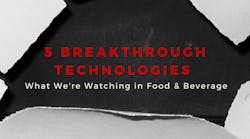Food Processing has identified five cutting-edge technologies that all use energy such as heat, electricity, pressure and vacuum, singly or in combination, in novel ways to process food better. They kill microorganisms, drive out moisture and perform other functions to preserve food, to make it safer and to make it taste better.
Spirajoule
The Spirajoule uses an electrically heated auger plus steam to treat spices, herbs, nuts, grains and other bulk product.
Spirajoule technology is a way to reduce or eliminate the bacterial load of low-moisture powders and bulk solids. It uses an electrically heated auger conveyor in an enclosed space to treat products such as herbs, nuts, grains, seeds and other powders and bulk solids. While the product is being conveyed, it is exposed to superheated steam, which completes the heating profile while imparting moisture.
Spirajoule heats more reliably than steam alone would, says Aaron Norris, president of Norris Thermal Technologies, Spirajoule’s sole North American distributor. The technology is manufactured and sold by the French firm Etia SAS, under the trade name Safesteril.
“We use the heated screw to really drive energy to the product and to the atmosphere around the product, and then the steam to add moisture both in saturated form and in superheated steam to get the results that we want as far as debacteriazation,” Norris says.
The system’s humidity, moisture, time and temperature are controllable for a wide variety of foods. The result can range from five-log pasteurization to commercial sterilization. Because the exposure to steam occurs while the product is moving, there is no chance for condensation to occur, so that even sticky powders can be treated without agglomerating.
Norris Thermal has installed more than 10 Spirajoule lines in North America, for products including spices, nutraceuticals, almonds, milled flaxseed, capsicums and chopped mint. Some of the users are toll processors who do a variety of products, including chopped vegetables, grains and seeds.
Microwave-assisted thermal sterilization can achieve shelf-stability in products where it was previously unavailable, like whole-muscle meat and seafood.
Microwave-assisted thermal sterilization
Microwave-assisted thermal sterilization (MATS) has the potential to bring shelf-stability to a range of products where it had been unthinkable before, including whole-muscle meat and seafood.
Like many food innovations, MATS got its start with the U.S. military, to increase the quality of the shelf-stable combat rations known as Meals Ready to Eat. It was developed by researchers at Washington State University and is being commercialized by 915Labs, a startup based in Denver.
MATS involves immersing a package in water and exposing it to microwaves at 915 MHz, which induces an internal temperature of about 250 F. That heat generates steam and internal pressure; to keep the package from bursting or popping its lid, the water surrounding it is pressurized. MATS-treated products can be in a variety of plastic packaging, rigid as well as flexible, as long as it has no metal component.
“MATS packaging looks a lot like plastic retort packaging,” says Roberta Brewster, VP of business development for 915Labs. “The only requirement for packaging is that no metals can be used, given that we are employing microwaves. Customers can design/create their own as well.”
A popular option for packaging is vacuum-sealing to a tray, especially for whole-muscle cuts of meats and seafood. This displays product to its best advantage, especially in a shelf-stable environment, where there is no cooler door or other barrier between the consumer and the product.
“Vacuum sealing improves microwave application, as it removes air, but it is not required,” Brewster says. “It does help displaying ingredients best when the package includes multiple components together or when you want to process packages upside down in the system to optimize for throughput.”
A similar treatment is microwave assisted pasteurization (MAPS), which follows the same procedure as MATS, only at lower temperatures – 167 F to 194 F. These temperatures do not generate enough internal pressure to damage the packaging, so the water is not pressurized. MAPS allows food that is normally sterilized through retorting to be sold in refrigerated form, from beverages to ready-to-eat meals.
Products that can be treated with MATS or MAPS run the gamut of food: whole proteins, vegetables, rice, grains, pasta, hummus and other dips, sauces, beverages, whole meals and more.
The largest customer for MATS technology remains the U.S. military. Amazon and Walmart have been reported as expressing interest. Brewster declined to identify any current commercial customers, although she said the biggest one to date is in India.
Radiant energy vacuum
Moon Cheese, a crunchy snack that’s 100% cheese, was developed as a way to market radiant energy vacuum technology by the technology’s supplier.
Microwaves are used in another cutting-edge technology: radiant energy vacuum. REV involves driving moisture from food by exposing it to microwaves while it’s under vacuum. The moisture removal is uniform and can be calibrated to each application.
“Radiant energy vacuum technology offers end users a precise way of removing moisture from any food products at controllable low temperatures,” says Brent Charleton, president and CEO of EnWave Corp., the sole provider of the technology. “It allows for superior retention of nutritional properties, color and flavor, because the process is very fast, and it also allows for flexible final moisture content.”
The key, Carleton says, is that the microwaves dry the product uniformly instead of from the outside, while the vacuum decreases the boiling point of the product’s moisture, allowing it to be driven out faster.
Charleton estimates that about 70% of current customers of the technology use it for dairy, shelf-stable snacks and ingredients, and the remaining 30% for fruits and vegetables.
Like many truly innovative technologies, it encountered initial resistance. “Back in 2013, when we were beginning to commercialize our technology in a meaningful way, we were having a lot of pushback from middle to senior managers of CPG companies that weren’t quite ready to put their own necks on the line on whether the technology was going to add value for the company,” Charleton says. “So we said, we should do it ourselves.”
EnWave started a subsidiary in Washington state, birthplace of REV, called NutraDried. Its sole product is Moon Cheese, a snack made from 100% cheese dried to a crunch by REV.
“This isn’t a wheat-based product with a little cheese sprinkled on it,” says Michael Pytlinski, CEO of NutraDried. “This is 100% cheese, and natural cheese at that.” The high protein, low carbs and clean label are unusual and appealing for a shelf-stable snack, Pytlinski says. Moon Cheese is distributed nationwide in more than 25,000 retail stores, including Whole Foods, Publix, Starbucks, Target, Wegmans and more, and is due to relaunch with a new packaging design at the end of this year.
Potential new markets for REV technology, Charleton says, include meat, seafood, herbs and spices. Cannabis is especially suited to REV because it requires precise and reliable removal of moisture, down to 1% for extraction of CBD and THC, he says.
High-pressure processing is a batch process but can be scaled up without increasing the equipment’s footprint. Photo: JBT Avure
High-pressure processing
High-pressure processing (HPP) kills microorganisms inside a sealed package without any heat whatsoever, extending its shelf life while maintaining its freshness.
As the name implies, HPP works entirely through pressure. Food is sealed in watertight flexible packaging and immersed in a tank in water that is brought up to pressure of 87,000 psi or more. This literally squeezes microorganisms to death, but since it’s being applied on all sides, it doesn’t distort or rupture the product – even whole pieces like sausage or deli meat slices.
The latter, in fact, is one of the biggest current markets for HPP. Deli meat and guacamole (the first product to be commercially processed with HPP) make up about 60% of the HPP market, says Joyce Longfield, chairperson of the Cold Pressure Council and VP of product innovation for Good Foods, a processor of dips, dressings and wet salads.


